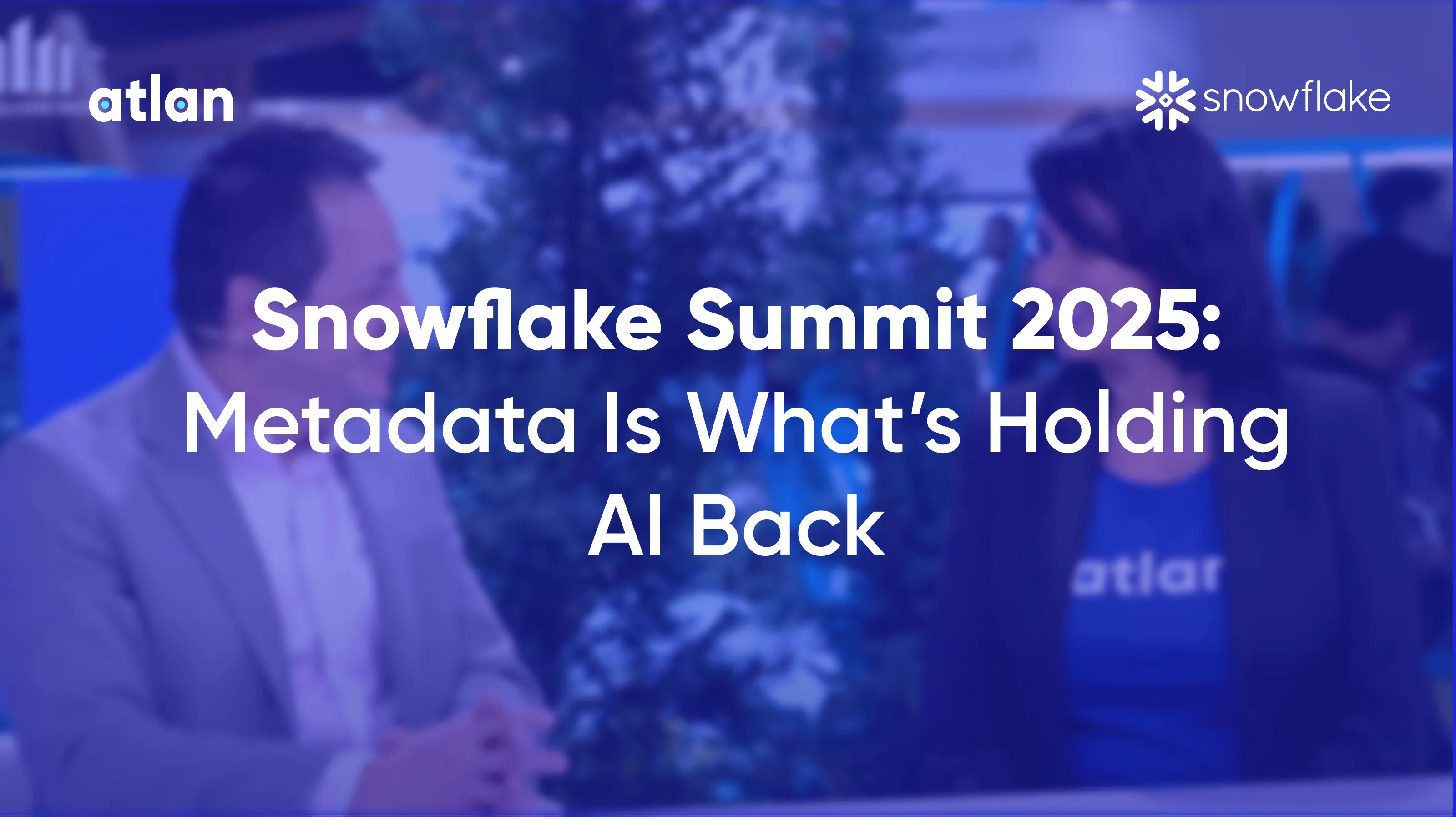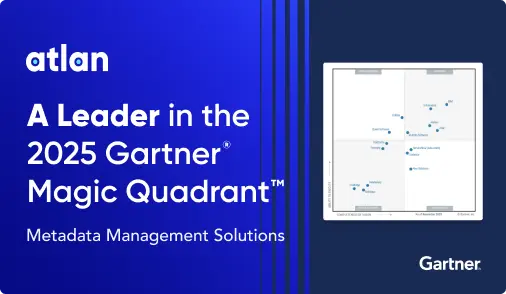Snowflake Summit 2025 Takeaways: How Metadata Unlocks Real AI

Last Updated on: June 19th, 2025 | 8 min read
Snowflake Summit 2025 wraps up Thursday, June 5, but one conversation kept surfacing in every hallway and keynote: AI isn’t stuck because of models, it’s stuck because of missing context.
The point landed in a quick Data Cloud Now studio interview when Snowflake EVP of Product Christian Kleinerman shared:
“None of that works if you don’t have the right metadata.”
Atlan Co-founder Prukalpa Sankar drove it home:
“Context is the bridge that carries AI from pilot projects to production reality.”
With over 40,000 data professionals witnessing this paradigm shift, these Snowflake Summit takeaways reveal why governance-first AI strategies are becoming the competitive differentiator for enterprise success.

The top 5 critical Snowflake Summit takeaways
Permalink to “The top 5 critical Snowflake Summit takeaways”Takeaway 1: Agents can’t see without context. Cortex Agents dazzles, and every query thrives on tags, lineage, and policies at runtime.
Takeaway 2: Governance is now mission critical. Horizon auto-tags PII, surfaces lineage, and lets Copilot ask, “Which tables are missing tags?”—raw ingredients that Atlan’s active-metadata engine turns into enterprise guardrails.
Takeaway 3: Speed + semantics in one shot. Semantic Views bring a single metric language; Gen-2 Warehouses run it 2.1× faster with zero tuning.
Takeaway 4: One policy layer, everywhere. Snowflake Postgres and soon-to-arrive Agentic Apps mean SQL, transactional, and AI workloads share the same rules.
Takeaway 5: Proof, not promises. Affirm, Workday, and Canva showed that codified context shrinks audits, speeds chatbot roll-outs, and unifies creative metrics.
Top 5 announcements from Snowflake Summit 2025
Permalink to “Top 5 announcements from Snowflake Summit 2025”1. AI agents broke out of the dashboard and they’re hungry for lineage
Permalink to “1. AI agents broke out of the dashboard and they’re hungry for lineage”Cortex Agents and the new Snowflake Intelligence workspace let anyone trigger SQL, APIs, or workflows in plain English. Every request still asks, “Do I have permission to touch this column?” Governance is no longer a checklist; it’s the runtime fuel that keeps agents safe.
2. Horizon makes governance native
Permalink to “2. Horizon makes governance native”The revamped Horizon Catalog now auto-tags sensitive data, propagates labels, and lets Copilot answer “Which tables are missing PII tags?”; model-level RBAC gates which roles can hit Anthropic or OpenAI models. Think of these as first-party primitives.
3. Semantic Views + Gen-2 Warehouses = trusted metrics at 2.1× speed
Permalink to “3. Semantic Views + Gen-2 Warehouses = trusted metrics at 2.1× speed”Semantic Views let teams store business metrics once and serve them to BI dashboards and AI agents. No more rogue definitions. Under the hood, Gen-2 Standard Warehouses push core analytics workloads 2.1× faster than Gen 1, with zero tuning required.
4. One policy layer for every workload: enter Snowflake Postgres and agentic apps
Permalink to “4. One policy layer for every workload: enter Snowflake Postgres and agentic apps”Snowflake surprised devs with a managed Snowflake Postgres engine: transactional tables that inherit the same security and tagging model as analytics data. Add the upcoming Agentic Apps category in Marketplace, pre-built Cortex workflows you can drop into your account, and suddenly governance has to span SQL, Postgres, and AI endpoints.
5. Governance graduated from gatekeeper to growth accelerator
Permalink to “5. Governance graduated from gatekeeper to growth accelerator”Snowflake underlined the point by naming Atlan its 2025 Data Governance Partner of the Year, framing “governance that disappears into everyday workflows” as the fastest path to becoming AI-native. The message is clear: when context travels with the data, innovation speeds up instead of slowing down.
Customer Spotlights: Real Results from Metadata-Driven Governance
Permalink to “Customer Spotlights: Real Results from Metadata-Driven Governance”Real brands, real numbers, one common thread: when context is codified, AI and analytics move faster than ever.
Affirm | Shift-Left Governance
Permalink to “Affirm | Shift-Left Governance”Governance move — Wired a metadata lakehouse into every pull request, auto-registering critical datasets, terms, and ownership.
Impact — GDPR audit prep now takes minutes instead of weeks, freeing engineers from spreadsheet clean-up.
“Spreadsheets became undifferentiated busy-work—metadata automation killed them.” — Ankit Singh, Affirm
Workday | Data Products, Finished & Semi-Finished
Permalink to “Workday | Data Products, Finished & Semi-Finished”Governance move — Mapped domain-owned data products (source → calculated → analytics) and embedded business semantics up front.
Impact — AI chatbots understand “top-performing rep” on day one; reusable, trusted datasets accelerate analytics across finance, HR, and sales.
Canva | Semantic Views Meet AI SQL
Permalink to “Canva | Semantic Views Meet AI SQL”Governance move — Uses Semantic Views to lock down a single definition for creative-asset metrics, feeding both BI dashboards and AI-SQL prompts.
Impact — Designers and analysts finally speak the same metric language, speeding asset classification while safeguarding IP.
How is Atlan’s Data Quality Studio a game-changer for AI readiness?
Permalink to “How is Atlan’s Data Quality Studio a game-changer for AI readiness?”The summit’s sleeper hit was Atlan’s launch of Data Quality Studio for Snowflake, which addresses a critical gap in the AI governance ecosystem. While most data quality tools focus on pipeline health, AI models fail when data isn’t fit for specific business purposes.
What it delivers:
- Human-defined, Snowflake-executed quality checks in natural language
- Real-time trust signals surfaced in BI tools, data catalogs, and Slack, allowing data consumers to instantly assess dataset fitness for specific AI use cases
- Unified trust center aggregating quality from multiple sources, providing single-pane data health assessment.
Why it matters:
Permalink to “Why it matters:”Traditional data quality tools focus on pipeline health, but AI models fail when data isn’t fit for specific business purposes. Data Quality Studio enables business teams to define expectations naturally while Snowflake executes validation at scale.
Atlan Data Quality is in private preview. Request access at atlan.com/data-quality-studio or through your Atlan or Snowflake representative.
Monday-morning moves: Turn Snowflake Summit Takeaways into action
Permalink to “Monday-morning moves: Turn Snowflake Summit Takeaways into action”- Stand up one business domain in your semantic layer. A shared, governed metric language beats a thousand one-off SQL look-ups.
- Prototype your first AI assistant after lineage and policies are rock-solid. Keep the agent (e.g., “sales-pipeline Q&A”) in a sandbox until you’ve pressure-tested access rules.
- Schedule lineage refreshes and policy-syncs so no one is flying blind. Fresh metadata prevents GenAI, BI, and reporting tools from masking stale context.
Strategic game plan inspired by Snowflake Summit 2025 takeaways
Permalink to “Strategic game plan inspired by Snowflake Summit 2025 takeaways”The most tactical Snowflake Summit 2025 takeaways came from customer case studies and expert panels. Here’s how data leaders are operationalizing AI trust:
In the next 90 days:
Permalink to “In the next 90 days:”- Launch Semantic Views for top business metrics to enforce shared meaning.
- Enable Horizon’s Sensitive-Data Insights, and partner with security teams to verify automated tagging.
- Pilot Cortex Agents for low-risk scenarios where metadata, lineage, and policies are already mature.
In the next 3–12 months:
Permalink to “In the next 3–12 months:”- Adopt a Data Product Operating Model to infuse business context across the data lifecycle.
- Shift Left on Governance by embedding metadata and policy tooling into development workflows.
- Surface Real-Time Trust Signals in business-facing apps to improve confidence in AI outputs.
Strategic bets for the long term:
Permalink to “Strategic bets for the long term:”- Build Metadata Lakehouses to act as the control plane for scalable AI governance.
- Invest in AI Governance Engineering to codify policies into infrastructure.
- Create Unified Trust Centers to centralize and communicate data quality and compliance across domains.
What Snowflake Summit takeaways mean for the future of AI
Permalink to “What Snowflake Summit takeaways mean for the future of AI”Snowflake Summit 2025 marks a turning point: from AI experimentation to operationalization. The most effective organizations treat metadata and governance as core infrastructure, not bolt-ons.
To win with enterprise AI:
- Don’t ship agents until access rules are battle-tested
- Keep metadata fresh to avoid hallucinations and data drift
- Codify context—it’s the new prerequisite for trust
The ultimate Snowflake Summit takeaway? Metadata is the trust layer for AI. And without trust, there is no transformation.
FAQs about Snowflake Summit 2025 key takeaways
Permalink to “FAQs about Snowflake Summit 2025 key takeaways”What are the key takeaways from Snowflake Summit 2025?
Permalink to “What are the key takeaways from Snowflake Summit 2025?”Snowflake Summit 2025 highlighted the shift from AI experimentation to operationalization, emphasizing the role of metadata in building trust. Major takeaways included the importance of semantic layers, Cortex Agents, Horizon’s governance capabilities, unified policy enforcement, and customer proof points from Affirm, Workday, and Canva.
Why is metadata critical to AI success according to Snowflake Summit 2025?
Permalink to “Why is metadata critical to AI success according to Snowflake Summit 2025?”Speakers and customer case studies at the summit stressed that AI fails without context. Metadata provides the business meaning, lineage, and policy enforcement needed for trusted, explainable, and scalable AI across the enterprise.
What is Snowflake’s Cortex Agent and how does it relate to governance?
Permalink to “What is Snowflake’s Cortex Agent and how does it relate to governance?”Cortex Agents are intelligent assistants that can execute SQL, API calls, and workflows using natural language. They rely on metadata like column-level access, tags, and lineage, to determine what actions are allowed, making governance a real-time runtime dependency, not just a checklist.
How can organizations implement Snowflake Summit 2025 takeaways immediately?
Permalink to “How can organizations implement Snowflake Summit 2025 takeaways immediately?”Teams can start by deploying Semantic Views for key metrics, validating sensitive-data tagging through Horizon, and piloting Cortex Agents in well-governed domains. Over time, they can adopt metadata lakehouses and real-time trust signals to support AI at scale.
What did the customer case studies reveal at Snowflake Summit 2025?
Permalink to “What did the customer case studies reveal at Snowflake Summit 2025?”Case studies from Affirm, Workday, and Canva demonstrated how codified context via metadata and governance, accelerates audits, improves chatbot performance, and aligns metrics across teams. These real-world wins validated that trust and context are now competitive differentiators.
Share this article
Atlan is the next-generation platform for data and AI governance. It is a control plane that stitches together a business's disparate data infrastructure, cataloging and enriching data with business context and security.
Related reads: Snowflake summit takeaways
Permalink to “Related reads: Snowflake summit takeaways”- Atlan Wins Snowflake Data Governance Data Cloud Product Partner of the Year
- Snowflake Cortex for AI & ML Analytics: Here’s Everything We Know So Far
- Snowflake Horizon for Data Governance: A Comprehensive Guide
- How to Set Up Data Governance for Snowflake: A Step-by-Step Guide
- Snowflake Data Discovery: Make your data assets accessible
- Snowflake Data Cloud Summit 2024: Get Ready and Fit for AI
- Snowflake Data Lineage: A Step-by-Step How to Guide
- How to Set Up a Data Catalog for Snowflake: A Step-by-Step Guide
- Snowflake Data Catalog: What, Why & How to Evaluate
- Snowflake Data Mesh: Step-by-Step Setup Guide
- Snowflake Data Security: A Complete Guide for 2025
- Snowflake Data Access Control Made Easy and Scalable
- Glossary for Snowflake: Shared Understanding Across Teams
- Personalized Data Discovery for Snowflake Data Assets
- Snowflake Data Dictionary
- Managing Metadata in Snowflake: A Comprehensive Guide
- Snowflake Data Compliance: Enhancing Native Features With A Unified Control Plane for Data
- How to Query Information Schema on Snowflake? Examples, Best Practices, and Tools





















